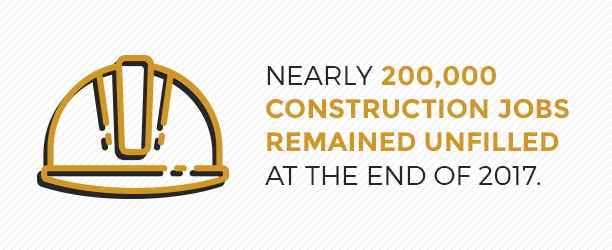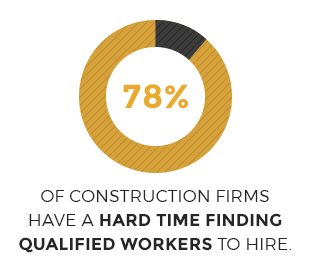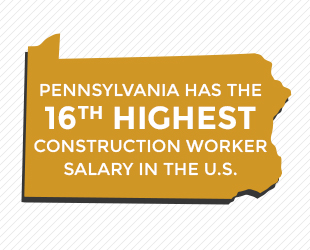Why 2019 is the Perfect Year to Start a Career in the Construction Industry
Seventy-five percent of construction firms indicated they would increase their headcount in 2018, according to the 2018 Construction Industry Hiring and Business Outlook. While an increase in numbers is a part of the plan, workforce shortages are still a struggle for the construction industry — according to the U.S. Bureau of Labor Statistics, nearly 200,000 construction jobs remained unfilled at the end of 2017. The demand for construction workers is high, making it a great career opportunity to pursue in 2019.
In addition to construction jobs being on the increase, the policies put in place at the federal, state and local levels continue to impact the demand for work, as well as the construction companies themselves. While the 2017 tax plan that passed was not construction-specific, it did come with a promise of private-activity bond (PAB) financing continuing uninterrupted and significant tax relief for contractors who are structured as pass-through entities and C Corporations — all positively impacting the construction industry. Upgrading roads, bridges and other public assets is an issue that has bipartisan support.
Perhaps some of these tax changes are part of the reason the income potential in the construction industry has seen a sharp increase since 2012. In the most recent data available from U.S. News and World Report, construction managers, who are near the top of the ladder in the industry, are reported to make a median salary of $89,300. This position is also ranked number 62 on the list of 100 Best Jobs.
Construction Industry Trends
While the construction job market seems to be positioned for success, there’s another component to construction jobs that makes it an exciting career choice. Those who pursue a career in construction have a unique opportunity to be a part of several trends that have started — and will continue — to shape the industry in 2019.
The construction industry of the future is an exciting one. It gives construction workers the ability to combine traditional work with cutting-edge technology like Building Information Modeling (BIM), Internet of Things (IoT), drones, robotics, virtual reality — and utilizing tools to create structures that are sustainable and quick to assemble. We’ve highlighted a few of these trends below.
Building Information Modeling (BIM)
This 6D technology gives you the ability to forecast issues you may run into before you begin building. It can reduce construction costs and increase safety — both of which combine to give you a faster, safer building process. While BIM is often a part of RFPs and government agencies, it’s expected that soon it will be a part of the construction and building codes.
Internet of Things (IoT)
Everything from smartphones to GPS works together to keep everyone connected on and off-site. It’s not about having the most technology — it’s about maximizing what you have to increase productivity. Sharing photos, documents, data, project management, logistics, time tracking, inventory and equipment are just some of the most common examples of tasks the Internet of Things helps construction workers to manage.
Drones
Having access to drone technology opens doors for construction companies. They can be used to map a construction site, inspect job sites, report changes and update clients on progress, among other things. It’s easy to brush off drones as a cool toy, or a tool to take cool aerial photos and videos, but the reality is there are implications for improving construction, too.
Virtual Reality
Using virtual reality for gaming or escaping to your favorite destination is fun, but it’s also something that can be used to sell a building or a building component. Giving your clients the opportunity to do a virtual walkthrough before you break ground is a powerful tool. Virtual reality is equally as powerful as a part of training those in construction jobs about safety.
Green Building
The green building market is estimated to be worth $81 billion — too big to be ignored. It’s also expected that in 2018, requests for green homes will increase by 64%. While the demand is high, it’s always a challenge for construction managers and contractors to adjust their process to ensure they meet all the requirements to obtain recognition as a green construction project.
Jobs in Construction
The types of jobs that are available within the construction industry vary from general to very specific. To get an idea of all of the careers available in this industry, think about all of the different aspects of a new building that come together. There are a lot of pieces, including planning and budgeting, loading and unloading of the equipment on site, building the frame and walls, installing everything from plumbing to electric and putting on the final touch of paint. All of these tasks capture part of a job within the construction industry.
The 2018 Construction Industry Hiring and Business Outlook shows that 78% of construction firms have a hard time finding qualified workers to hire. Since these firms are having a tough time finding qualified workers, they’re making changes to sweeten the deal — increasing base pay rates, adding incentives or bonuses and improved employee benefits are just a few of the perks you may find if you choose to search for one of these construction jobs in 2019.
Construction Worker
If you’re interested in a career in construction but aren’t sure where to start, try getting a job as a construction worker — it’s a great foundation. Not only do you get hands-on experience and learn more about the construction process, but you also get exposure to a variety of tasks — digging, knocking down walls, loading and unloading equipment, etc.
Chances are you’ll discover a part of construction you enjoy more than another, and then you have the opportunity to pursue whatever training is required to continue that career. You may also find you like a little bit of everything — in which case you may consider getting a degree or appropriate certification and becoming a construction manager.
Electrician
Every building needs electricity — and behind all the electric wiring is an electrician. This work can be dangerous, which is why it requires at least four years of training as an apprentice before going through the state licensing process. Before training an apprentice, some choose to attend a technical school to get a foundation of knowledge, but that isn’t required. It’s important to know that not all electricians do all electric work. There is some flexibility with specializing — for example, some electricians stick to residential electric systems, while others enjoy taking on installing, maintaining and fixing electrical systems for businesses.
Carpenter
The path to a career in carpentry is similar to that of an electrician in that you should complete a three to four-year training program, but instead of electrical wiring, carpenters’ specialty is wood. Through these programs, apprentices complete a minimum of 144 hours of paid technical training and thousands of hours of on-the-job training to learn skills like carpentry basics, blueprint reading, building code requirements, safety and mathematics. Union and contractor associations often sponsor apprenticeship programs, so that can be a great place to start.
Glazier
Once you have the wooden frames in place, you need someone who can perform similar functions with glass. That person is known as a glazier. While carpenters may be able to install glass that comes in the form of prefabricated windows, this cutting and installation process is more complex. Cutting, shaping, fitting and installing glass from large, heavy sheets of glass are the focus of the job. Sometimes the work is done on the ground, other times in the air.
Green buildings often call for energy-efficient glass products, which is sure to keep glaziers in business for the foreseeable future. Since a background in design, math and construction equipment and tools is helpful, training and apprenticeships are required for this career. The length varies depending on the type of glazier work you want to go into, with the most sophisticated, and highest paying, being in skyscrapers.
Plumber
You may think of a plumber as the person you call when something isn’t going quite right at home, but the reality is that plumbers are a big part of the planning process for a new structure. Plumbers develop blueprints to show where all of the pipes will run and make recommendations on where fixtures would make the best fit. In addition to planning, they’re also hands-on — installing and connecting all of the piping, alone or with a team. If water isn’t getting to one of your large fixtures, the plumber is the one to problem solve and troubleshoot.
The demand for green building also has an impact on plumbers as old structures are looking for more efficient plumbing systems — and new buildings are working hard to meet stricter water efficiency standards. To get started in this career, an apprenticeship is required — and if you went on to work independently, you would be required to have a license, which is given with two to five years of experience and passing an exam.
Painter
Once the structure is in place, applying paint, stain or another coating is the next step. While it may seem like this particular career is all done with a paint brush or a roller, that’s not the case. There are quite a few areas available for specializing in a career as a painter. For example, restoration work and decorative art are completely different than painting a new construction. In the apprenticeship for this career, you’ll spend a few years learning about how to match colors, using and caring for painting tools and equipment, wood finishing, application techniques and safety. After that, you’ll be ready to pursue your painting career.
Construction Manager
If you enjoy managing the process of construction, from beginning plans all the way through budgeting to breaking ground, this is a great career goal for you. This position is the best fit for someone who has a general interest in building and design and who has years of experience in the field. While it’s not always necessary, it’s becoming more and more important for careers in construction management to include not only experience but also a college education.
Major Infrastructure and Construction Projects in PA
Construction jobs in Pennsylvania in 2019 look particularly bright. According to recent data from the Bureau of Labor Statistics (BLS), Pennsylvania is ranked fifth in the United States for the number of construction workers. From 2016 to 2017, Pennsylvania also ranked fifth for its gain in the number of construction jobs year-over-year. What is it about the Keystone state that keeps it in the top five for construction? The population is part of it, but that’s not the only thing keeping construction jobs in Pennsylvania in 2019.
The reason for the bright future of construction jobs in Pennsylvania is significantly impacted by the state government, which has declared support for several construction-related projects through budget proposals or plans that are already in place. Here are a few of the most recent:
- $2.1 billion investment in roadway maintenance and highway and bridge capital projects through the Road Maintenance and Preservation (Road MaP) program in the next ten years.
- Rebuilding 490 miles of the Pennsylvania Turnpike and the northeast extension.
- $200 million investment over a five-year period in the Rural Commercial Routes program to improve roadways seeing fewer than 3,000 vehicles daily.
- $74 million investment for 13 drinking water, wastewater, stormwater and non-point source projects in 11 counties through the Pennsylvania Infrastructure Investment Authority (PENNVEST).
- Seven major pipeline projects throughout the state that total clearing the way for over 300 miles of pipe.
While this is not a complete list of all of the infrastructure and construction projects in Pennsylvania, you can see from this sample that this state has plenty of work to keep the construction industry busy. Another bonus is that when construction worker salaries are adjusted for inflation, Pennsylvania ranks as the state with the 16th highest construction worker salary — so the income for this industry is also above average.
How to Get Started on a Career in Construction
While the experience you need to get a job in construction depends on the type and level of job you’re looking for — all positions are looking for hands-on experience. In many cases, getting hands-on experience enables you to move up the ladder to continue to take on more responsibilities and generate more income.
At Clark Contractors, we’re constantly looking to add new construction employees to our team. We’ve been a family-owned business for three generations and have completed thousands of projects in a few different fields, including commercial buildings, industrial facilities and institutional projects. Our clients are from throughout the central and western Pennsylvania and northern Maryland areas. If our business sounds like one you’d like to join to kickstart or continue, your career in construction in 2019, take a moment and send us your resume by filling out our brief online form. We look forward to working with — and helping grow — the next generation of construction workers, regardless of what your area of interest or expertise might be.







